HRM 503 - Motivation, Job Design, and Work Environment Analysis
VerifiedAdded on 2024/06/28
|16
|4382
|175
Report
AI Summary
This report delves into the critical aspects of International Human Resource Management (HRM), focusing on motivational theories and their influence on employee behavior and affective processes. It identifies key motivational theories such as Maslow's hierarchy of needs, Adam's equity theory, Vroom's expectancy theory, reinforcement theory, and Locke's goal-setting theory, emphasizing the significant impact of reinforcement theory on shaping employee behavior through rewards and consequences. The report also describes the characteristics of a positive work environment, highlighting trust, respect, open communication, training and development opportunities, and motivation, and discusses how HR designs jobs to motivate employees by aligning job roles with employee abilities and organizational goals. Furthermore, it synthesizes Hackman and Oldham's job characteristics model with employee psychological states to explain work outcomes like intrinsic motivation, job satisfaction, and high-quality performance. Finally, the report explores the relationship between Maslow's general components and job characteristics, demonstrating how fulfilling basic needs and providing opportunities for growth can engage and motivate employees within organizations. Desklib provides similar solved assignments and past papers for students.
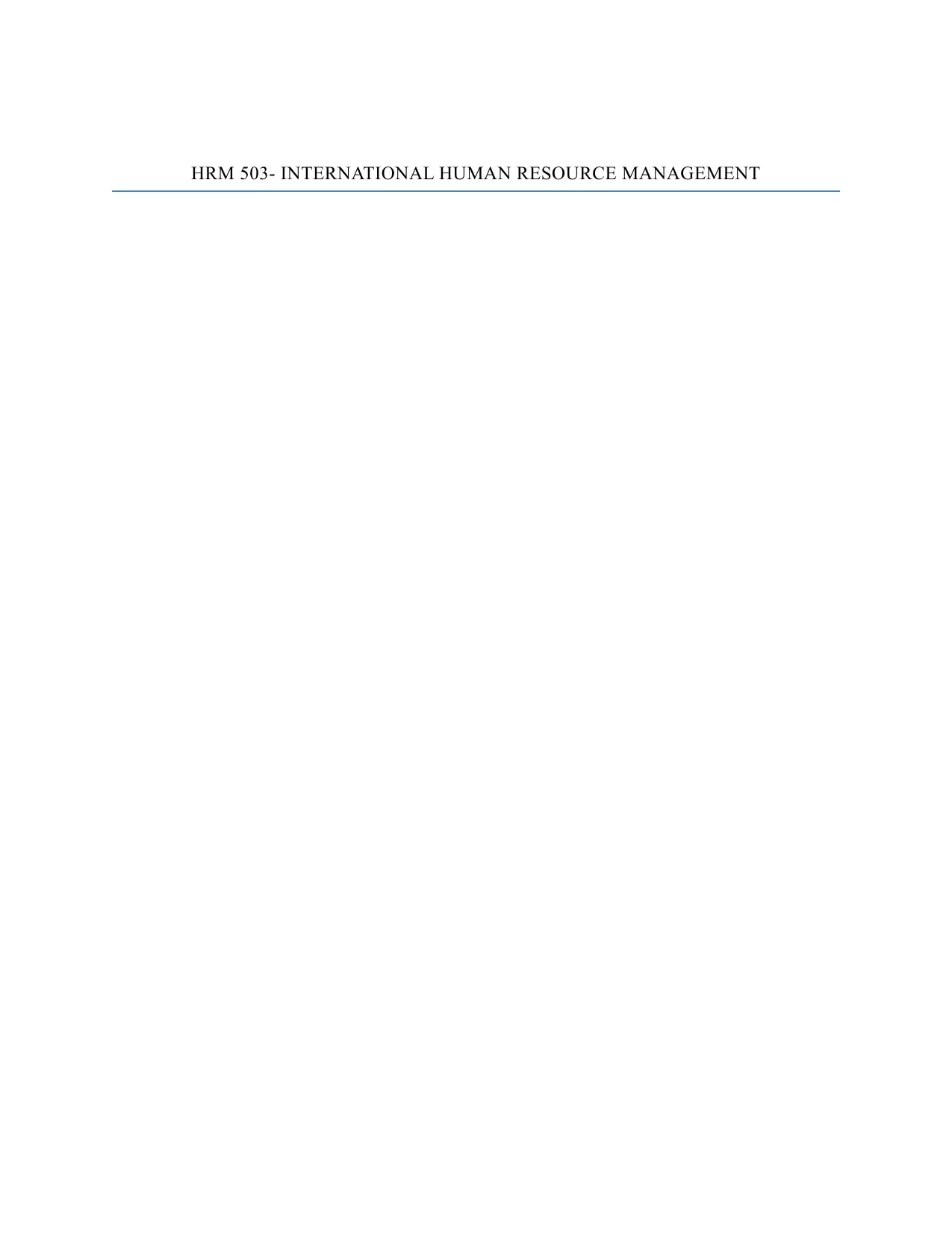
HRM 503- INTERNATIONAL HUMAN RESOURCE MANAGEMENT
Paraphrase This Document
Need a fresh take? Get an instant paraphrase of this document with our AI Paraphraser
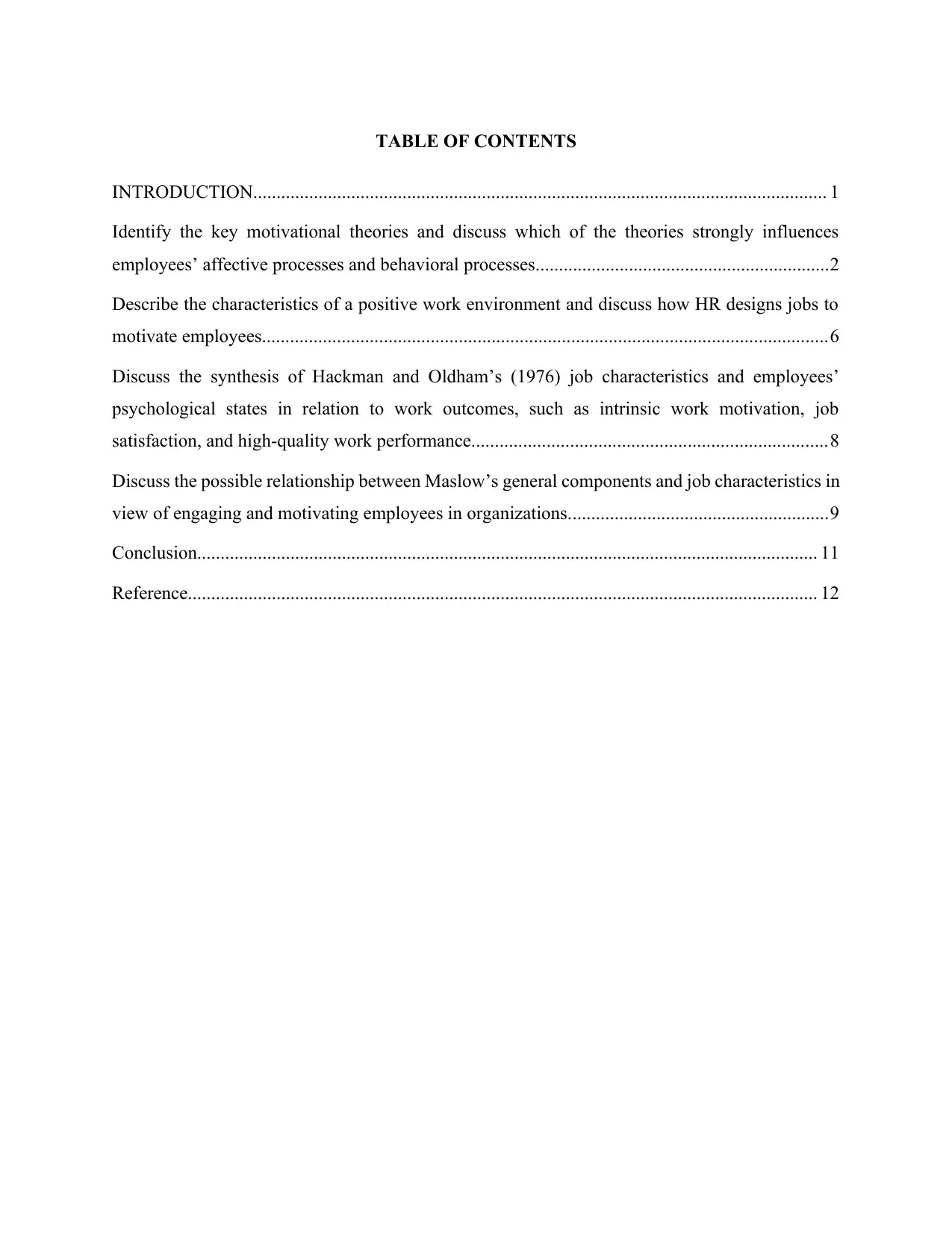
TABLE OF CONTENTS
INTRODUCTION........................................................................................................................... 1
Identify the key motivational theories and discuss which of the theories strongly influences
employees’ affective processes and behavioral processes...............................................................2
Describe the characteristics of a positive work environment and discuss how HR designs jobs to
motivate employees.........................................................................................................................6
Discuss the synthesis of Hackman and Oldham’s (1976) job characteristics and employees’
psychological states in relation to work outcomes, such as intrinsic work motivation, job
satisfaction, and high-quality work performance............................................................................8
Discuss the possible relationship between Maslow’s general components and job characteristics in
view of engaging and motivating employees in organizations........................................................9
Conclusion..................................................................................................................................... 11
Reference....................................................................................................................................... 12
INTRODUCTION........................................................................................................................... 1
Identify the key motivational theories and discuss which of the theories strongly influences
employees’ affective processes and behavioral processes...............................................................2
Describe the characteristics of a positive work environment and discuss how HR designs jobs to
motivate employees.........................................................................................................................6
Discuss the synthesis of Hackman and Oldham’s (1976) job characteristics and employees’
psychological states in relation to work outcomes, such as intrinsic work motivation, job
satisfaction, and high-quality work performance............................................................................8
Discuss the possible relationship between Maslow’s general components and job characteristics in
view of engaging and motivating employees in organizations........................................................9
Conclusion..................................................................................................................................... 11
Reference....................................................................................................................................... 12
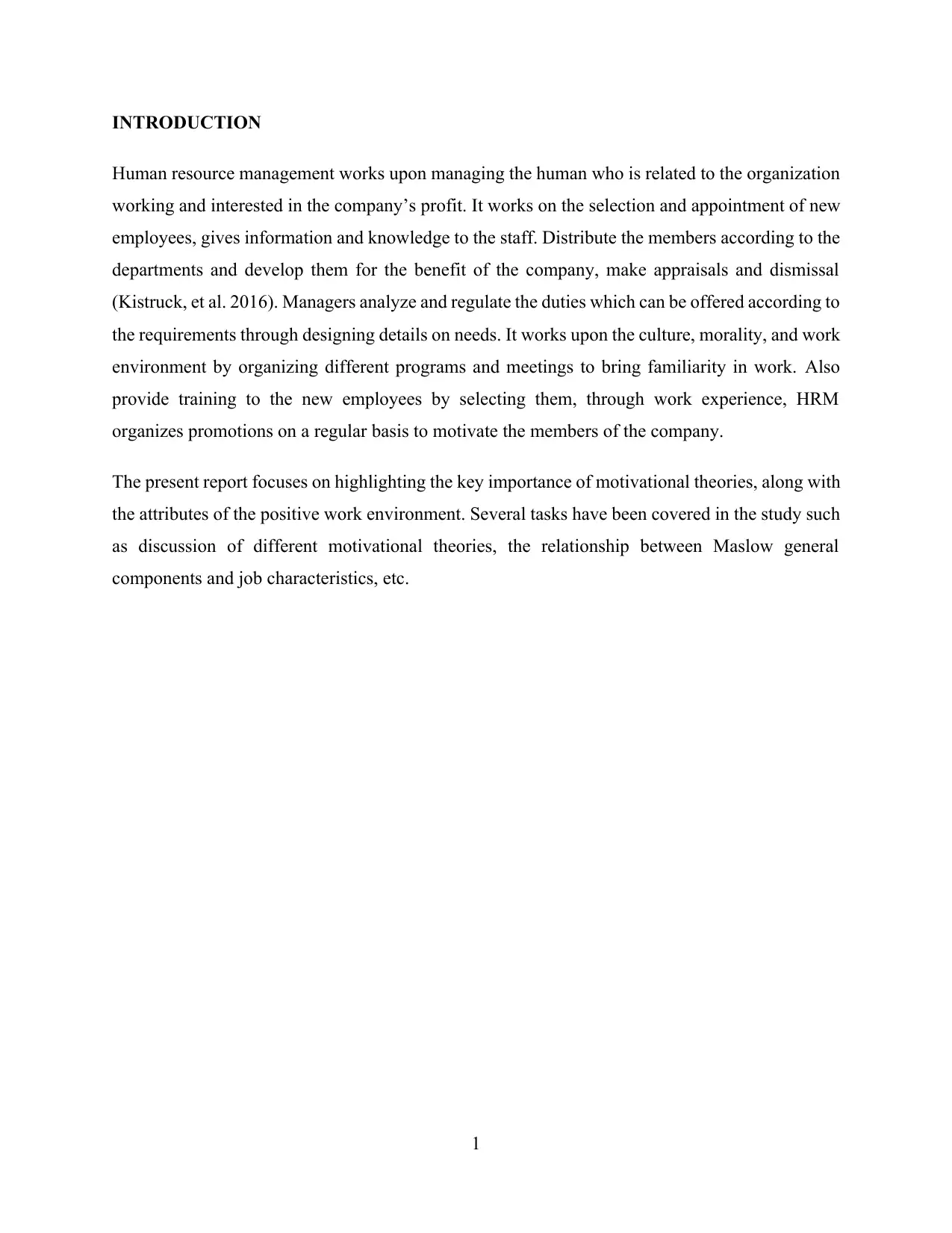
INTRODUCTION
Human resource management works upon managing the human who is related to the organization
working and interested in the company’s profit. It works on the selection and appointment of new
employees, gives information and knowledge to the staff. Distribute the members according to the
departments and develop them for the benefit of the company, make appraisals and dismissal
(Kistruck, et al. 2016). Managers analyze and regulate the duties which can be offered according to
the requirements through designing details on needs. It works upon the culture, morality, and work
environment by organizing different programs and meetings to bring familiarity in work. Also
provide training to the new employees by selecting them, through work experience, HRM
organizes promotions on a regular basis to motivate the members of the company.
The present report focuses on highlighting the key importance of motivational theories, along with
the attributes of the positive work environment. Several tasks have been covered in the study such
as discussion of different motivational theories, the relationship between Maslow general
components and job characteristics, etc.
1
Human resource management works upon managing the human who is related to the organization
working and interested in the company’s profit. It works on the selection and appointment of new
employees, gives information and knowledge to the staff. Distribute the members according to the
departments and develop them for the benefit of the company, make appraisals and dismissal
(Kistruck, et al. 2016). Managers analyze and regulate the duties which can be offered according to
the requirements through designing details on needs. It works upon the culture, morality, and work
environment by organizing different programs and meetings to bring familiarity in work. Also
provide training to the new employees by selecting them, through work experience, HRM
organizes promotions on a regular basis to motivate the members of the company.
The present report focuses on highlighting the key importance of motivational theories, along with
the attributes of the positive work environment. Several tasks have been covered in the study such
as discussion of different motivational theories, the relationship between Maslow general
components and job characteristics, etc.
1
⊘ This is a preview!⊘
Do you want full access?
Subscribe today to unlock all pages.

Trusted by 1+ million students worldwide
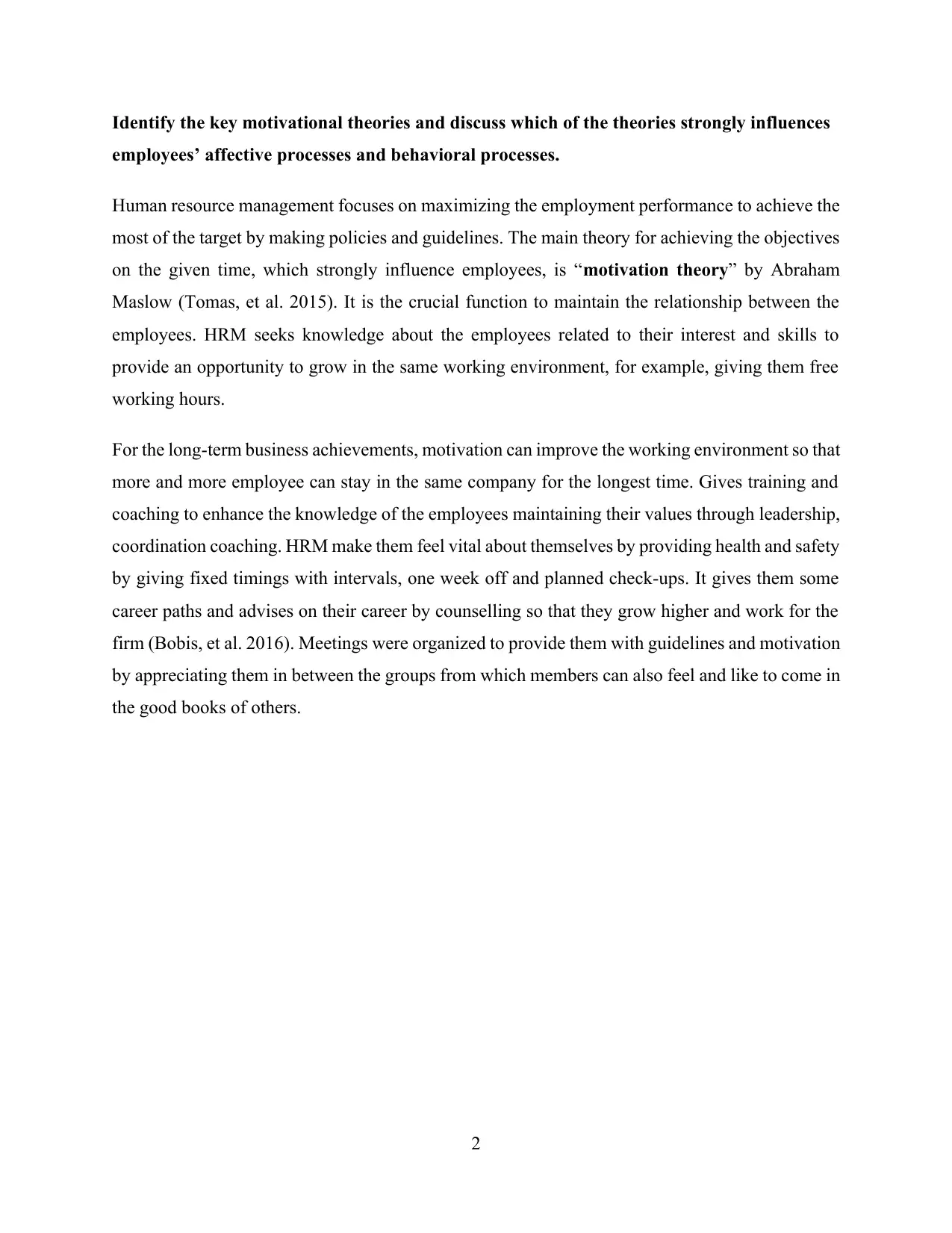
Identify the key motivational theories and discuss which of the theories strongly influences
employees’ affective processes and behavioral processes.
Human resource management focuses on maximizing the employment performance to achieve the
most of the target by making policies and guidelines. The main theory for achieving the objectives
on the given time, which strongly influence employees, is “motivation theory” by Abraham
Maslow (Tomas, et al. 2015). It is the crucial function to maintain the relationship between the
employees. HRM seeks knowledge about the employees related to their interest and skills to
provide an opportunity to grow in the same working environment, for example, giving them free
working hours.
For the long-term business achievements, motivation can improve the working environment so that
more and more employee can stay in the same company for the longest time. Gives training and
coaching to enhance the knowledge of the employees maintaining their values through leadership,
coordination coaching. HRM make them feel vital about themselves by providing health and safety
by giving fixed timings with intervals, one week off and planned check-ups. It gives them some
career paths and advises on their career by counselling so that they grow higher and work for the
firm (Bobis, et al. 2016). Meetings were organized to provide them with guidelines and motivation
by appreciating them in between the groups from which members can also feel and like to come in
the good books of others.
2
employees’ affective processes and behavioral processes.
Human resource management focuses on maximizing the employment performance to achieve the
most of the target by making policies and guidelines. The main theory for achieving the objectives
on the given time, which strongly influence employees, is “motivation theory” by Abraham
Maslow (Tomas, et al. 2015). It is the crucial function to maintain the relationship between the
employees. HRM seeks knowledge about the employees related to their interest and skills to
provide an opportunity to grow in the same working environment, for example, giving them free
working hours.
For the long-term business achievements, motivation can improve the working environment so that
more and more employee can stay in the same company for the longest time. Gives training and
coaching to enhance the knowledge of the employees maintaining their values through leadership,
coordination coaching. HRM make them feel vital about themselves by providing health and safety
by giving fixed timings with intervals, one week off and planned check-ups. It gives them some
career paths and advises on their career by counselling so that they grow higher and work for the
firm (Bobis, et al. 2016). Meetings were organized to provide them with guidelines and motivation
by appreciating them in between the groups from which members can also feel and like to come in
the good books of others.
2
Paraphrase This Document
Need a fresh take? Get an instant paraphrase of this document with our AI Paraphraser
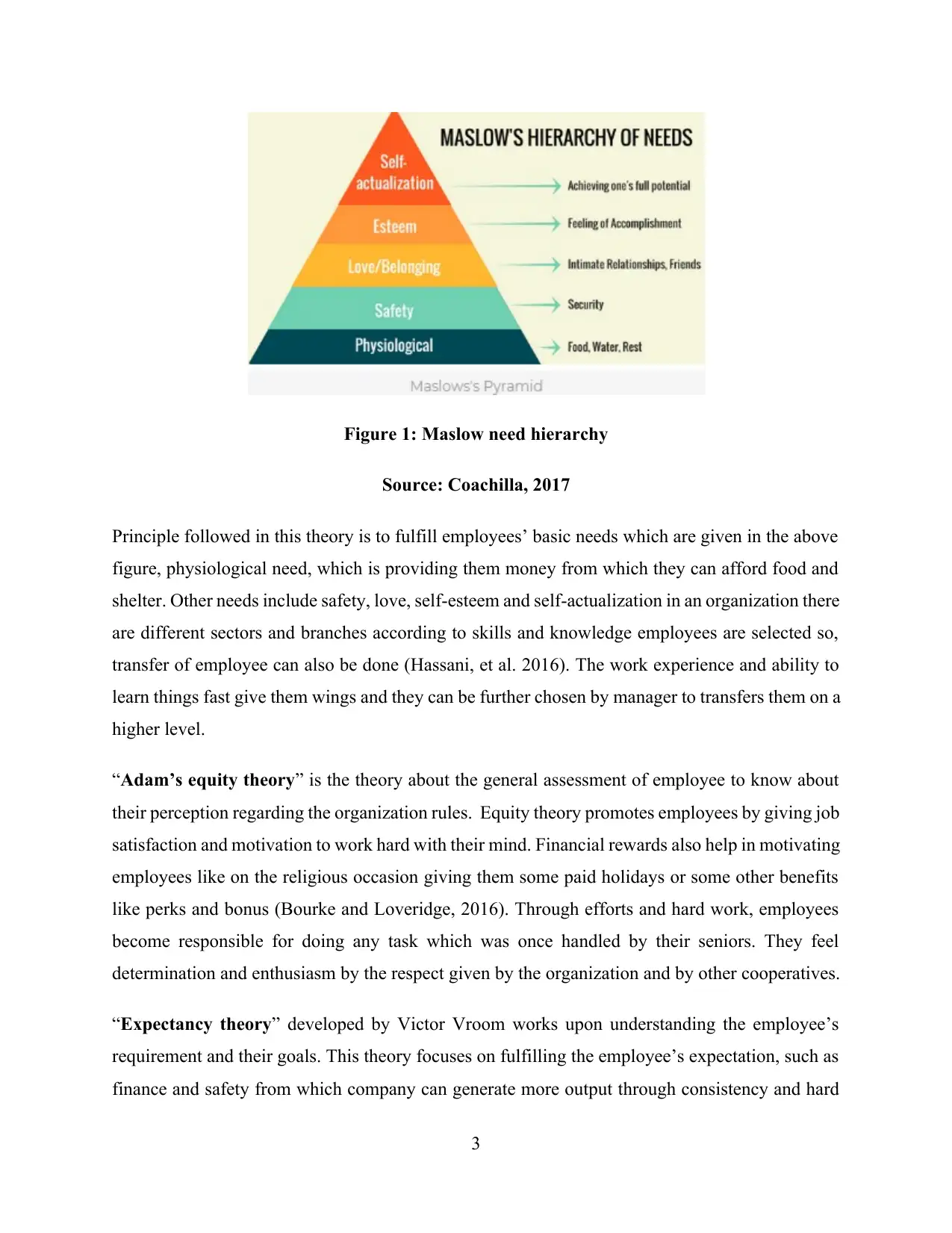
Figure 1: Maslow need hierarchy
Source: Coachilla, 2017
Principle followed in this theory is to fulfill employees’ basic needs which are given in the above
figure, physiological need, which is providing them money from which they can afford food and
shelter. Other needs include safety, love, self-esteem and self-actualization in an organization there
are different sectors and branches according to skills and knowledge employees are selected so,
transfer of employee can also be done (Hassani, et al. 2016). The work experience and ability to
learn things fast give them wings and they can be further chosen by manager to transfers them on a
higher level.
“Adam’s equity theory” is the theory about the general assessment of employee to know about
their perception regarding the organization rules. Equity theory promotes employees by giving job
satisfaction and motivation to work hard with their mind. Financial rewards also help in motivating
employees like on the religious occasion giving them some paid holidays or some other benefits
like perks and bonus (Bourke and Loveridge, 2016). Through efforts and hard work, employees
become responsible for doing any task which was once handled by their seniors. They feel
determination and enthusiasm by the respect given by the organization and by other cooperatives.
“Expectancy theory” developed by Victor Vroom works upon understanding the employee’s
requirement and their goals. This theory focuses on fulfilling the employee’s expectation, such as
finance and safety from which company can generate more output through consistency and hard
3
Source: Coachilla, 2017
Principle followed in this theory is to fulfill employees’ basic needs which are given in the above
figure, physiological need, which is providing them money from which they can afford food and
shelter. Other needs include safety, love, self-esteem and self-actualization in an organization there
are different sectors and branches according to skills and knowledge employees are selected so,
transfer of employee can also be done (Hassani, et al. 2016). The work experience and ability to
learn things fast give them wings and they can be further chosen by manager to transfers them on a
higher level.
“Adam’s equity theory” is the theory about the general assessment of employee to know about
their perception regarding the organization rules. Equity theory promotes employees by giving job
satisfaction and motivation to work hard with their mind. Financial rewards also help in motivating
employees like on the religious occasion giving them some paid holidays or some other benefits
like perks and bonus (Bourke and Loveridge, 2016). Through efforts and hard work, employees
become responsible for doing any task which was once handled by their seniors. They feel
determination and enthusiasm by the respect given by the organization and by other cooperatives.
“Expectancy theory” developed by Victor Vroom works upon understanding the employee’s
requirement and their goals. This theory focuses on fulfilling the employee’s expectation, such as
finance and safety from which company can generate more output through consistency and hard
3
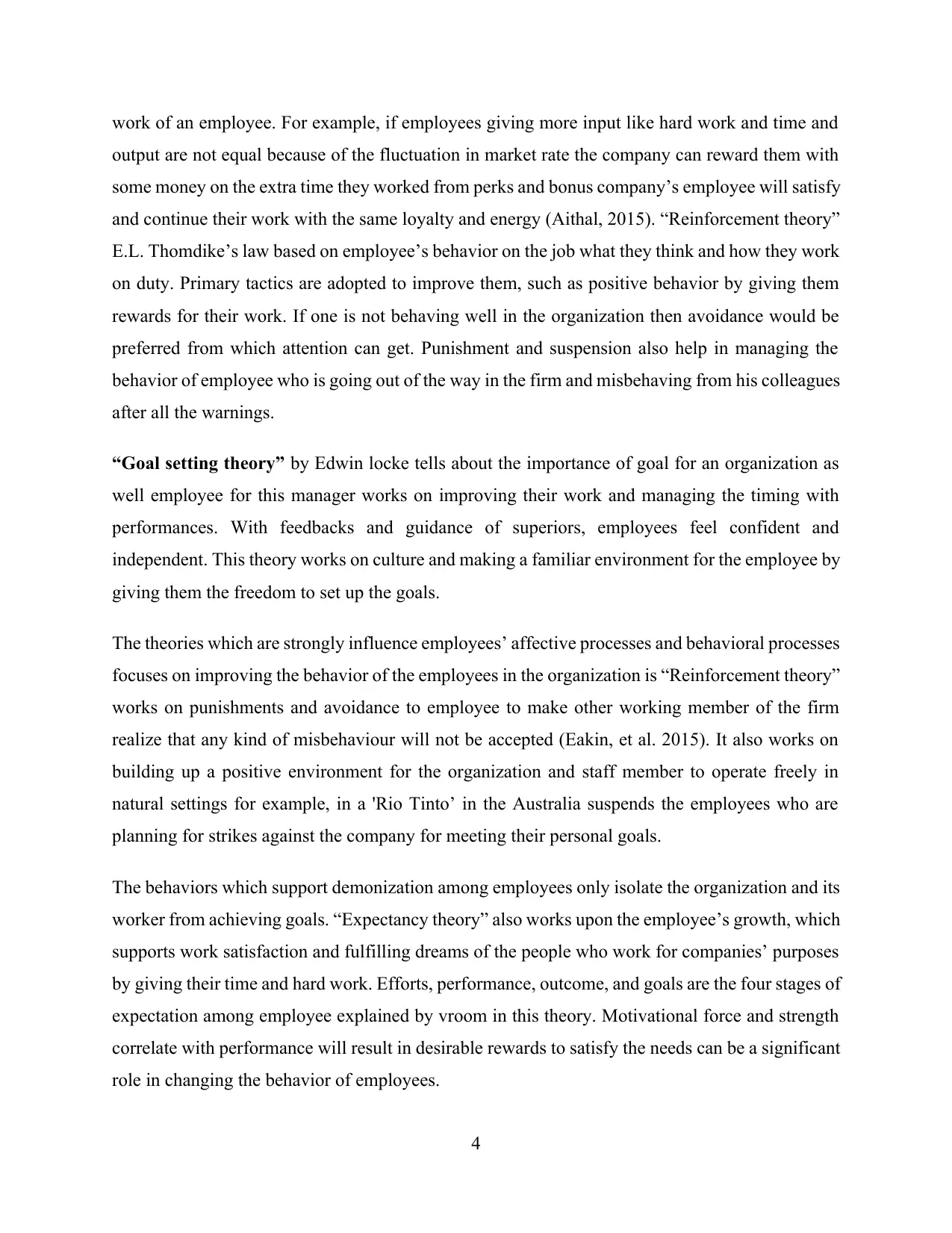
work of an employee. For example, if employees giving more input like hard work and time and
output are not equal because of the fluctuation in market rate the company can reward them with
some money on the extra time they worked from perks and bonus company’s employee will satisfy
and continue their work with the same loyalty and energy (Aithal, 2015). “Reinforcement theory”
E.L. Thomdike’s law based on employee’s behavior on the job what they think and how they work
on duty. Primary tactics are adopted to improve them, such as positive behavior by giving them
rewards for their work. If one is not behaving well in the organization then avoidance would be
preferred from which attention can get. Punishment and suspension also help in managing the
behavior of employee who is going out of the way in the firm and misbehaving from his colleagues
after all the warnings.
“Goal setting theory” by Edwin locke tells about the importance of goal for an organization as
well employee for this manager works on improving their work and managing the timing with
performances. With feedbacks and guidance of superiors, employees feel confident and
independent. This theory works on culture and making a familiar environment for the employee by
giving them the freedom to set up the goals.
The theories which are strongly influence employees’ affective processes and behavioral processes
focuses on improving the behavior of the employees in the organization is “Reinforcement theory”
works on punishments and avoidance to employee to make other working member of the firm
realize that any kind of misbehaviour will not be accepted (Eakin, et al. 2015). It also works on
building up a positive environment for the organization and staff member to operate freely in
natural settings for example, in a 'Rio Tinto’ in the Australia suspends the employees who are
planning for strikes against the company for meeting their personal goals.
The behaviors which support demonization among employees only isolate the organization and its
worker from achieving goals. “Expectancy theory” also works upon the employee’s growth, which
supports work satisfaction and fulfilling dreams of the people who work for companies’ purposes
by giving their time and hard work. Efforts, performance, outcome, and goals are the four stages of
expectation among employee explained by vroom in this theory. Motivational force and strength
correlate with performance will result in desirable rewards to satisfy the needs can be a significant
role in changing the behavior of employees.
4
output are not equal because of the fluctuation in market rate the company can reward them with
some money on the extra time they worked from perks and bonus company’s employee will satisfy
and continue their work with the same loyalty and energy (Aithal, 2015). “Reinforcement theory”
E.L. Thomdike’s law based on employee’s behavior on the job what they think and how they work
on duty. Primary tactics are adopted to improve them, such as positive behavior by giving them
rewards for their work. If one is not behaving well in the organization then avoidance would be
preferred from which attention can get. Punishment and suspension also help in managing the
behavior of employee who is going out of the way in the firm and misbehaving from his colleagues
after all the warnings.
“Goal setting theory” by Edwin locke tells about the importance of goal for an organization as
well employee for this manager works on improving their work and managing the timing with
performances. With feedbacks and guidance of superiors, employees feel confident and
independent. This theory works on culture and making a familiar environment for the employee by
giving them the freedom to set up the goals.
The theories which are strongly influence employees’ affective processes and behavioral processes
focuses on improving the behavior of the employees in the organization is “Reinforcement theory”
works on punishments and avoidance to employee to make other working member of the firm
realize that any kind of misbehaviour will not be accepted (Eakin, et al. 2015). It also works on
building up a positive environment for the organization and staff member to operate freely in
natural settings for example, in a 'Rio Tinto’ in the Australia suspends the employees who are
planning for strikes against the company for meeting their personal goals.
The behaviors which support demonization among employees only isolate the organization and its
worker from achieving goals. “Expectancy theory” also works upon the employee’s growth, which
supports work satisfaction and fulfilling dreams of the people who work for companies’ purposes
by giving their time and hard work. Efforts, performance, outcome, and goals are the four stages of
expectation among employee explained by vroom in this theory. Motivational force and strength
correlate with performance will result in desirable rewards to satisfy the needs can be a significant
role in changing the behavior of employees.
4
⊘ This is a preview!⊘
Do you want full access?
Subscribe today to unlock all pages.

Trusted by 1+ million students worldwide

5
Paraphrase This Document
Need a fresh take? Get an instant paraphrase of this document with our AI Paraphraser
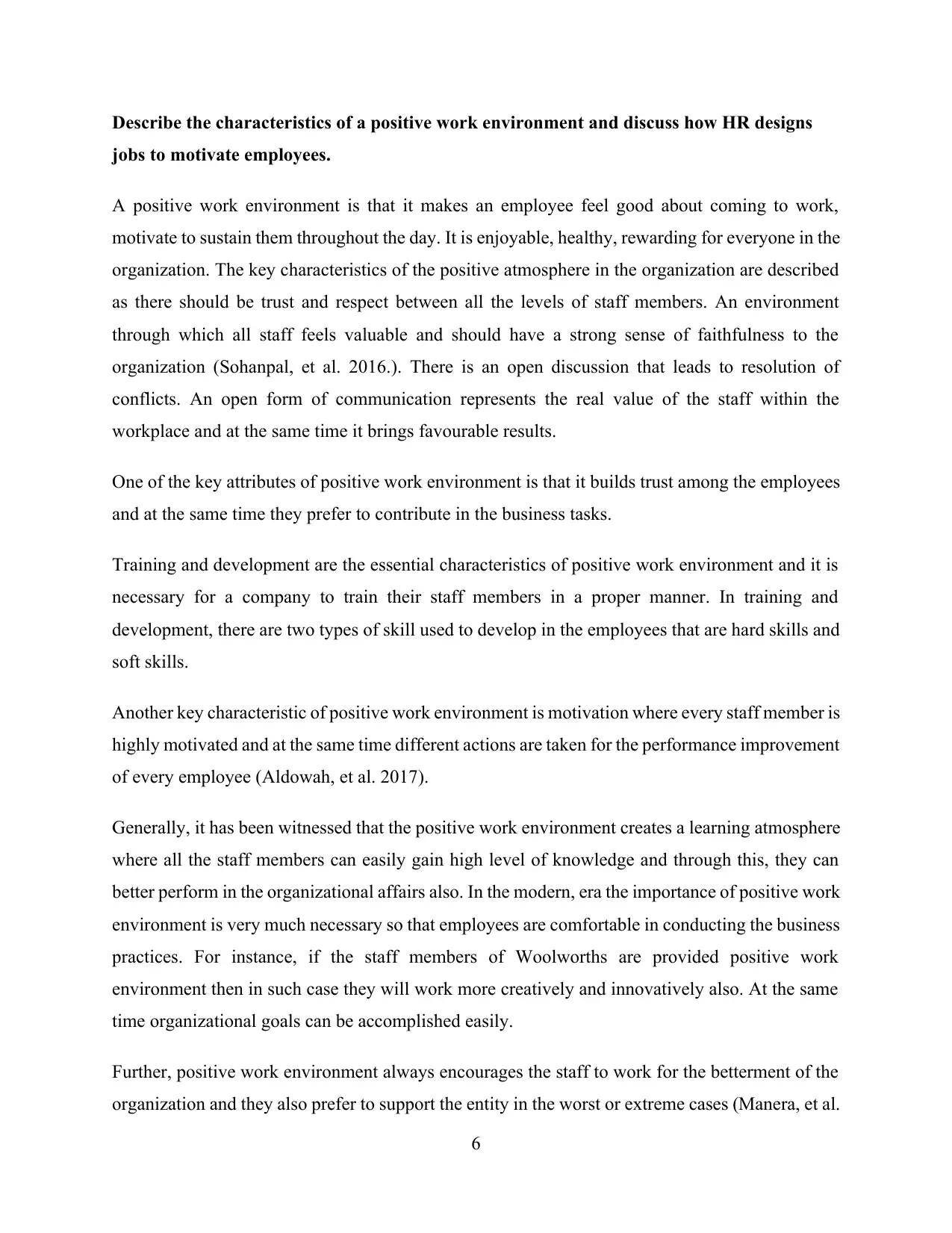
Describe the characteristics of a positive work environment and discuss how HR designs
jobs to motivate employees.
A positive work environment is that it makes an employee feel good about coming to work,
motivate to sustain them throughout the day. It is enjoyable, healthy, rewarding for everyone in the
organization. The key characteristics of the positive atmosphere in the organization are described
as there should be trust and respect between all the levels of staff members. An environment
through which all staff feels valuable and should have a strong sense of faithfulness to the
organization (Sohanpal, et al. 2016.). There is an open discussion that leads to resolution of
conflicts. An open form of communication represents the real value of the staff within the
workplace and at the same time it brings favourable results.
One of the key attributes of positive work environment is that it builds trust among the employees
and at the same time they prefer to contribute in the business tasks.
Training and development are the essential characteristics of positive work environment and it is
necessary for a company to train their staff members in a proper manner. In training and
development, there are two types of skill used to develop in the employees that are hard skills and
soft skills.
Another key characteristic of positive work environment is motivation where every staff member is
highly motivated and at the same time different actions are taken for the performance improvement
of every employee (Aldowah, et al. 2017).
Generally, it has been witnessed that the positive work environment creates a learning atmosphere
where all the staff members can easily gain high level of knowledge and through this, they can
better perform in the organizational affairs also. In the modern, era the importance of positive work
environment is very much necessary so that employees are comfortable in conducting the business
practices. For instance, if the staff members of Woolworths are provided positive work
environment then in such case they will work more creatively and innovatively also. At the same
time organizational goals can be accomplished easily.
Further, positive work environment always encourages the staff to work for the betterment of the
organization and they also prefer to support the entity in the worst or extreme cases (Manera, et al.
6
jobs to motivate employees.
A positive work environment is that it makes an employee feel good about coming to work,
motivate to sustain them throughout the day. It is enjoyable, healthy, rewarding for everyone in the
organization. The key characteristics of the positive atmosphere in the organization are described
as there should be trust and respect between all the levels of staff members. An environment
through which all staff feels valuable and should have a strong sense of faithfulness to the
organization (Sohanpal, et al. 2016.). There is an open discussion that leads to resolution of
conflicts. An open form of communication represents the real value of the staff within the
workplace and at the same time it brings favourable results.
One of the key attributes of positive work environment is that it builds trust among the employees
and at the same time they prefer to contribute in the business tasks.
Training and development are the essential characteristics of positive work environment and it is
necessary for a company to train their staff members in a proper manner. In training and
development, there are two types of skill used to develop in the employees that are hard skills and
soft skills.
Another key characteristic of positive work environment is motivation where every staff member is
highly motivated and at the same time different actions are taken for the performance improvement
of every employee (Aldowah, et al. 2017).
Generally, it has been witnessed that the positive work environment creates a learning atmosphere
where all the staff members can easily gain high level of knowledge and through this, they can
better perform in the organizational affairs also. In the modern, era the importance of positive work
environment is very much necessary so that employees are comfortable in conducting the business
practices. For instance, if the staff members of Woolworths are provided positive work
environment then in such case they will work more creatively and innovatively also. At the same
time organizational goals can be accomplished easily.
Further, positive work environment always encourages the staff to work for the betterment of the
organization and they also prefer to support the entity in the worst or extreme cases (Manera, et al.
6
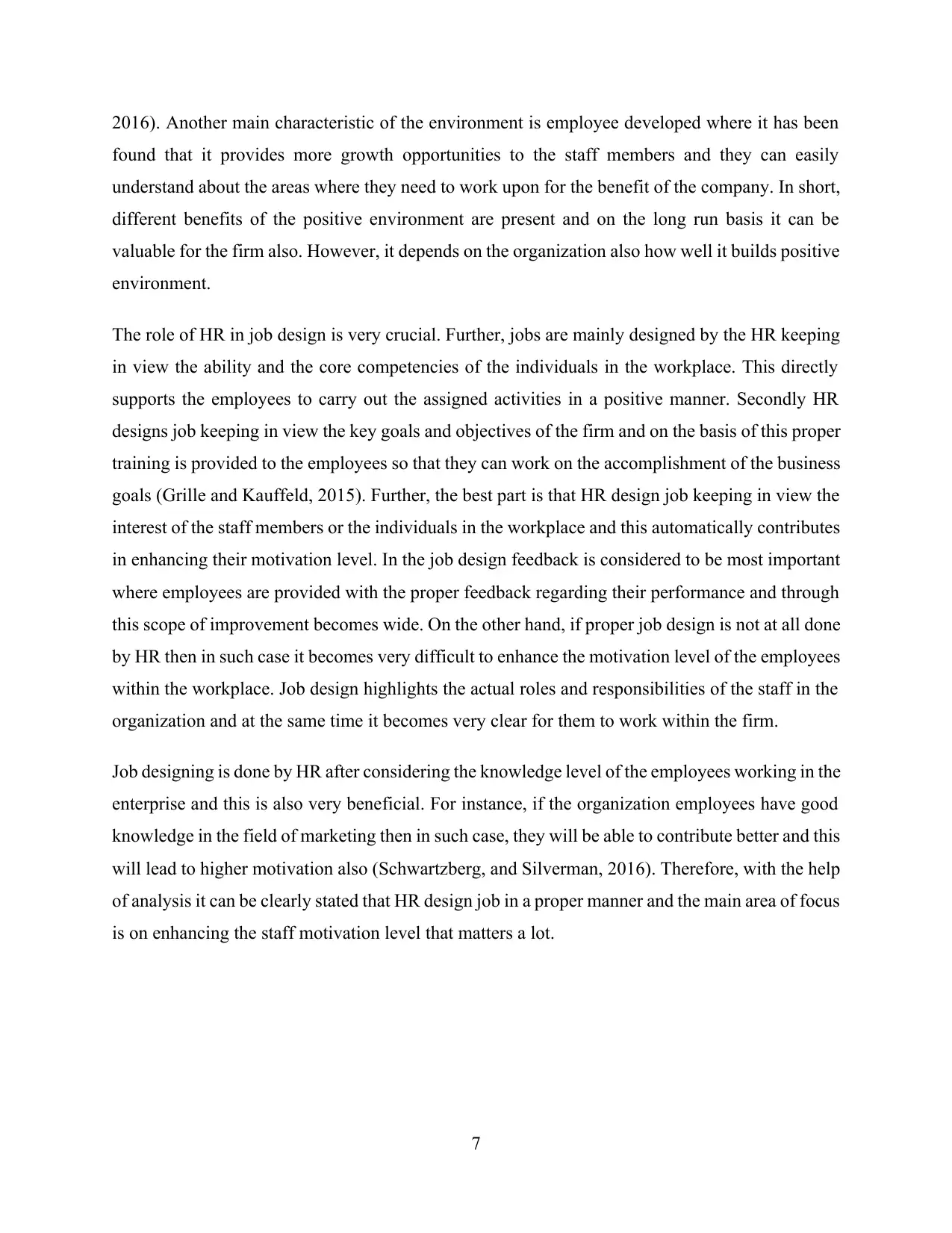
2016). Another main characteristic of the environment is employee developed where it has been
found that it provides more growth opportunities to the staff members and they can easily
understand about the areas where they need to work upon for the benefit of the company. In short,
different benefits of the positive environment are present and on the long run basis it can be
valuable for the firm also. However, it depends on the organization also how well it builds positive
environment.
The role of HR in job design is very crucial. Further, jobs are mainly designed by the HR keeping
in view the ability and the core competencies of the individuals in the workplace. This directly
supports the employees to carry out the assigned activities in a positive manner. Secondly HR
designs job keeping in view the key goals and objectives of the firm and on the basis of this proper
training is provided to the employees so that they can work on the accomplishment of the business
goals (Grille and Kauffeld, 2015). Further, the best part is that HR design job keeping in view the
interest of the staff members or the individuals in the workplace and this automatically contributes
in enhancing their motivation level. In the job design feedback is considered to be most important
where employees are provided with the proper feedback regarding their performance and through
this scope of improvement becomes wide. On the other hand, if proper job design is not at all done
by HR then in such case it becomes very difficult to enhance the motivation level of the employees
within the workplace. Job design highlights the actual roles and responsibilities of the staff in the
organization and at the same time it becomes very clear for them to work within the firm.
Job designing is done by HR after considering the knowledge level of the employees working in the
enterprise and this is also very beneficial. For instance, if the organization employees have good
knowledge in the field of marketing then in such case, they will be able to contribute better and this
will lead to higher motivation also (Schwartzberg, and Silverman, 2016). Therefore, with the help
of analysis it can be clearly stated that HR design job in a proper manner and the main area of focus
is on enhancing the staff motivation level that matters a lot.
7
found that it provides more growth opportunities to the staff members and they can easily
understand about the areas where they need to work upon for the benefit of the company. In short,
different benefits of the positive environment are present and on the long run basis it can be
valuable for the firm also. However, it depends on the organization also how well it builds positive
environment.
The role of HR in job design is very crucial. Further, jobs are mainly designed by the HR keeping
in view the ability and the core competencies of the individuals in the workplace. This directly
supports the employees to carry out the assigned activities in a positive manner. Secondly HR
designs job keeping in view the key goals and objectives of the firm and on the basis of this proper
training is provided to the employees so that they can work on the accomplishment of the business
goals (Grille and Kauffeld, 2015). Further, the best part is that HR design job keeping in view the
interest of the staff members or the individuals in the workplace and this automatically contributes
in enhancing their motivation level. In the job design feedback is considered to be most important
where employees are provided with the proper feedback regarding their performance and through
this scope of improvement becomes wide. On the other hand, if proper job design is not at all done
by HR then in such case it becomes very difficult to enhance the motivation level of the employees
within the workplace. Job design highlights the actual roles and responsibilities of the staff in the
organization and at the same time it becomes very clear for them to work within the firm.
Job designing is done by HR after considering the knowledge level of the employees working in the
enterprise and this is also very beneficial. For instance, if the organization employees have good
knowledge in the field of marketing then in such case, they will be able to contribute better and this
will lead to higher motivation also (Schwartzberg, and Silverman, 2016). Therefore, with the help
of analysis it can be clearly stated that HR design job in a proper manner and the main area of focus
is on enhancing the staff motivation level that matters a lot.
7
⊘ This is a preview!⊘
Do you want full access?
Subscribe today to unlock all pages.

Trusted by 1+ million students worldwide
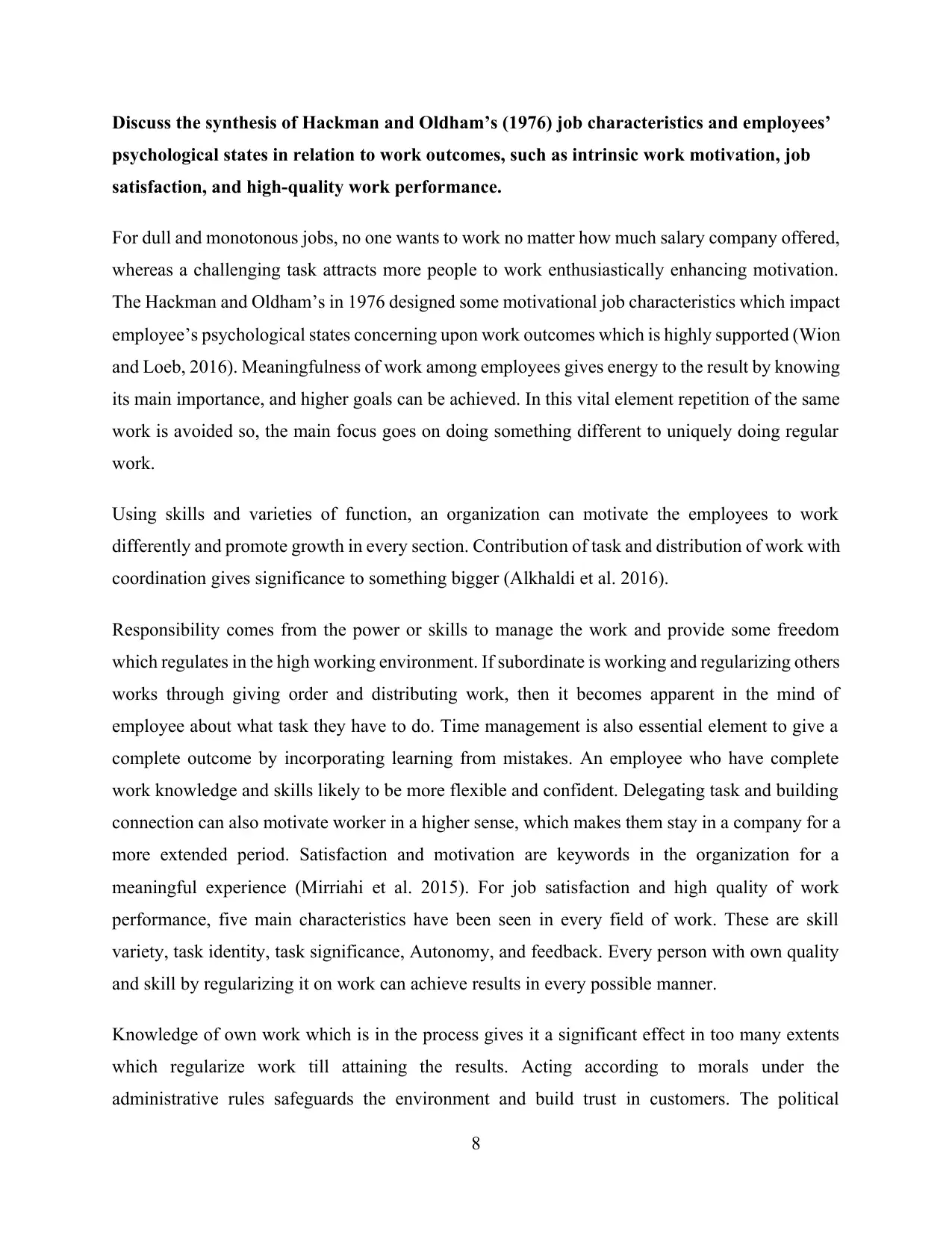
Discuss the synthesis of Hackman and Oldham’s (1976) job characteristics and employees’
psychological states in relation to work outcomes, such as intrinsic work motivation, job
satisfaction, and high-quality work performance.
For dull and monotonous jobs, no one wants to work no matter how much salary company offered,
whereas a challenging task attracts more people to work enthusiastically enhancing motivation.
The Hackman and Oldham’s in 1976 designed some motivational job characteristics which impact
employee’s psychological states concerning upon work outcomes which is highly supported (Wion
and Loeb, 2016). Meaningfulness of work among employees gives energy to the result by knowing
its main importance, and higher goals can be achieved. In this vital element repetition of the same
work is avoided so, the main focus goes on doing something different to uniquely doing regular
work.
Using skills and varieties of function, an organization can motivate the employees to work
differently and promote growth in every section. Contribution of task and distribution of work with
coordination gives significance to something bigger (Alkhaldi et al. 2016).
Responsibility comes from the power or skills to manage the work and provide some freedom
which regulates in the high working environment. If subordinate is working and regularizing others
works through giving order and distributing work, then it becomes apparent in the mind of
employee about what task they have to do. Time management is also essential element to give a
complete outcome by incorporating learning from mistakes. An employee who have complete
work knowledge and skills likely to be more flexible and confident. Delegating task and building
connection can also motivate worker in a higher sense, which makes them stay in a company for a
more extended period. Satisfaction and motivation are keywords in the organization for a
meaningful experience (Mirriahi et al. 2015). For job satisfaction and high quality of work
performance, five main characteristics have been seen in every field of work. These are skill
variety, task identity, task significance, Autonomy, and feedback. Every person with own quality
and skill by regularizing it on work can achieve results in every possible manner.
Knowledge of own work which is in the process gives it a significant effect in too many extents
which regularize work till attaining the results. Acting according to morals under the
administrative rules safeguards the environment and build trust in customers. The political
8
psychological states in relation to work outcomes, such as intrinsic work motivation, job
satisfaction, and high-quality work performance.
For dull and monotonous jobs, no one wants to work no matter how much salary company offered,
whereas a challenging task attracts more people to work enthusiastically enhancing motivation.
The Hackman and Oldham’s in 1976 designed some motivational job characteristics which impact
employee’s psychological states concerning upon work outcomes which is highly supported (Wion
and Loeb, 2016). Meaningfulness of work among employees gives energy to the result by knowing
its main importance, and higher goals can be achieved. In this vital element repetition of the same
work is avoided so, the main focus goes on doing something different to uniquely doing regular
work.
Using skills and varieties of function, an organization can motivate the employees to work
differently and promote growth in every section. Contribution of task and distribution of work with
coordination gives significance to something bigger (Alkhaldi et al. 2016).
Responsibility comes from the power or skills to manage the work and provide some freedom
which regulates in the high working environment. If subordinate is working and regularizing others
works through giving order and distributing work, then it becomes apparent in the mind of
employee about what task they have to do. Time management is also essential element to give a
complete outcome by incorporating learning from mistakes. An employee who have complete
work knowledge and skills likely to be more flexible and confident. Delegating task and building
connection can also motivate worker in a higher sense, which makes them stay in a company for a
more extended period. Satisfaction and motivation are keywords in the organization for a
meaningful experience (Mirriahi et al. 2015). For job satisfaction and high quality of work
performance, five main characteristics have been seen in every field of work. These are skill
variety, task identity, task significance, Autonomy, and feedback. Every person with own quality
and skill by regularizing it on work can achieve results in every possible manner.
Knowledge of own work which is in the process gives it a significant effect in too many extents
which regularize work till attaining the results. Acting according to morals under the
administrative rules safeguards the environment and build trust in customers. The political
8
Paraphrase This Document
Need a fresh take? Get an instant paraphrase of this document with our AI Paraphraser
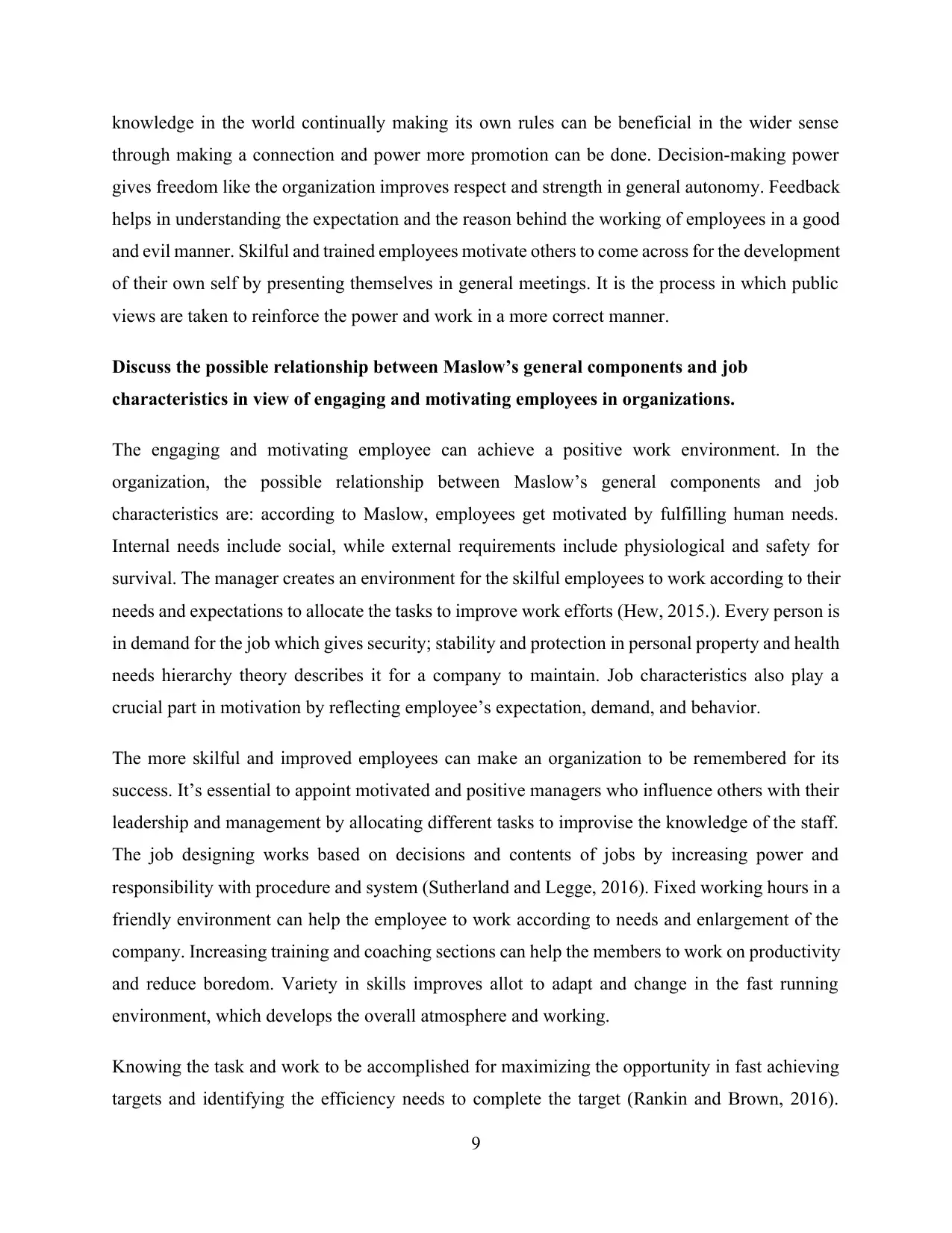
knowledge in the world continually making its own rules can be beneficial in the wider sense
through making a connection and power more promotion can be done. Decision-making power
gives freedom like the organization improves respect and strength in general autonomy. Feedback
helps in understanding the expectation and the reason behind the working of employees in a good
and evil manner. Skilful and trained employees motivate others to come across for the development
of their own self by presenting themselves in general meetings. It is the process in which public
views are taken to reinforce the power and work in a more correct manner.
Discuss the possible relationship between Maslow’s general components and job
characteristics in view of engaging and motivating employees in organizations.
The engaging and motivating employee can achieve a positive work environment. In the
organization, the possible relationship between Maslow’s general components and job
characteristics are: according to Maslow, employees get motivated by fulfilling human needs.
Internal needs include social, while external requirements include physiological and safety for
survival. The manager creates an environment for the skilful employees to work according to their
needs and expectations to allocate the tasks to improve work efforts (Hew, 2015.). Every person is
in demand for the job which gives security; stability and protection in personal property and health
needs hierarchy theory describes it for a company to maintain. Job characteristics also play a
crucial part in motivation by reflecting employee’s expectation, demand, and behavior.
The more skilful and improved employees can make an organization to be remembered for its
success. It’s essential to appoint motivated and positive managers who influence others with their
leadership and management by allocating different tasks to improvise the knowledge of the staff.
The job designing works based on decisions and contents of jobs by increasing power and
responsibility with procedure and system (Sutherland and Legge, 2016). Fixed working hours in a
friendly environment can help the employee to work according to needs and enlargement of the
company. Increasing training and coaching sections can help the members to work on productivity
and reduce boredom. Variety in skills improves allot to adapt and change in the fast running
environment, which develops the overall atmosphere and working.
Knowing the task and work to be accomplished for maximizing the opportunity in fast achieving
targets and identifying the efficiency needs to complete the target (Rankin and Brown, 2016).
9
through making a connection and power more promotion can be done. Decision-making power
gives freedom like the organization improves respect and strength in general autonomy. Feedback
helps in understanding the expectation and the reason behind the working of employees in a good
and evil manner. Skilful and trained employees motivate others to come across for the development
of their own self by presenting themselves in general meetings. It is the process in which public
views are taken to reinforce the power and work in a more correct manner.
Discuss the possible relationship between Maslow’s general components and job
characteristics in view of engaging and motivating employees in organizations.
The engaging and motivating employee can achieve a positive work environment. In the
organization, the possible relationship between Maslow’s general components and job
characteristics are: according to Maslow, employees get motivated by fulfilling human needs.
Internal needs include social, while external requirements include physiological and safety for
survival. The manager creates an environment for the skilful employees to work according to their
needs and expectations to allocate the tasks to improve work efforts (Hew, 2015.). Every person is
in demand for the job which gives security; stability and protection in personal property and health
needs hierarchy theory describes it for a company to maintain. Job characteristics also play a
crucial part in motivation by reflecting employee’s expectation, demand, and behavior.
The more skilful and improved employees can make an organization to be remembered for its
success. It’s essential to appoint motivated and positive managers who influence others with their
leadership and management by allocating different tasks to improvise the knowledge of the staff.
The job designing works based on decisions and contents of jobs by increasing power and
responsibility with procedure and system (Sutherland and Legge, 2016). Fixed working hours in a
friendly environment can help the employee to work according to needs and enlargement of the
company. Increasing training and coaching sections can help the members to work on productivity
and reduce boredom. Variety in skills improves allot to adapt and change in the fast running
environment, which develops the overall atmosphere and working.
Knowing the task and work to be accomplished for maximizing the opportunity in fast achieving
targets and identifying the efficiency needs to complete the target (Rankin and Brown, 2016).
9
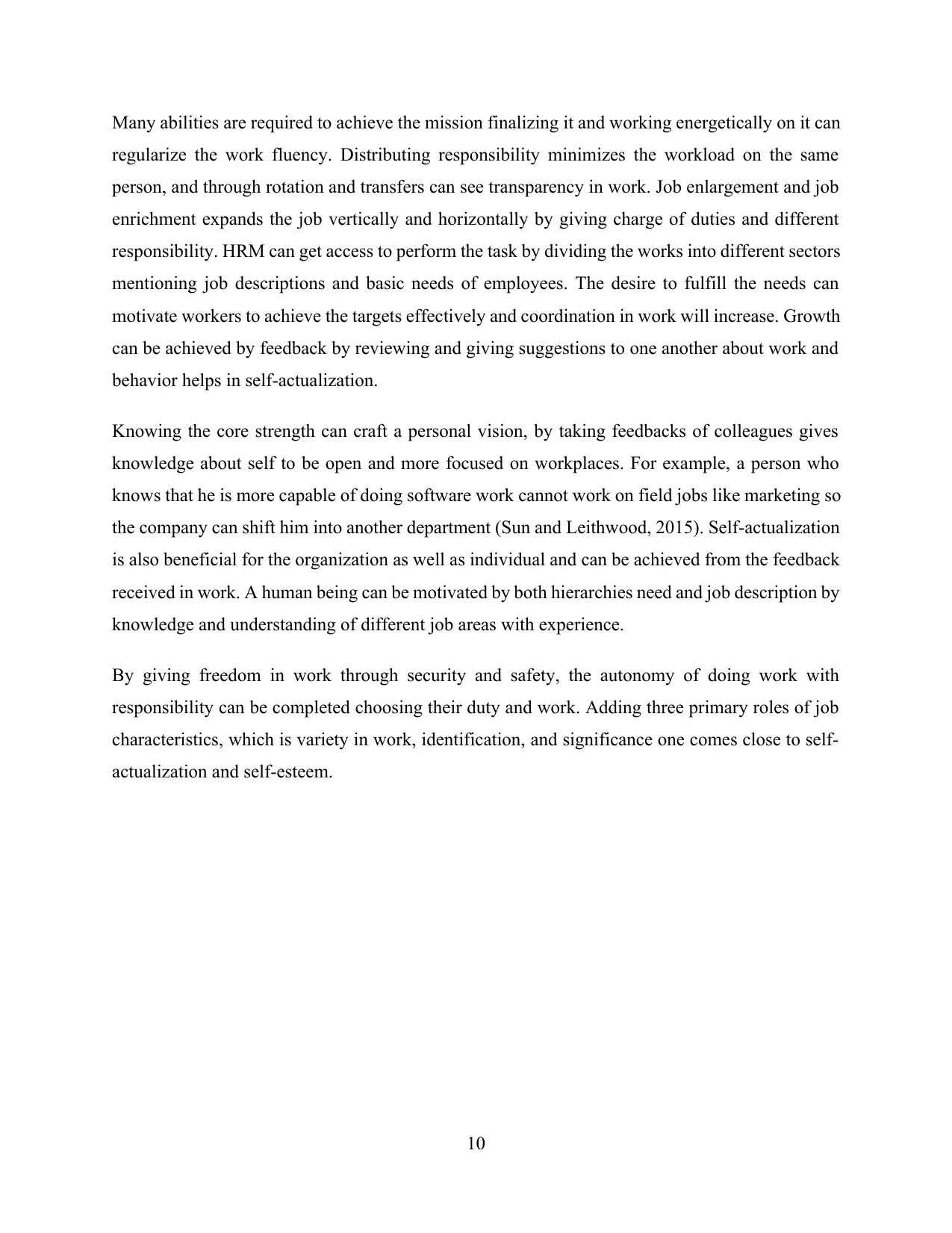
Many abilities are required to achieve the mission finalizing it and working energetically on it can
regularize the work fluency. Distributing responsibility minimizes the workload on the same
person, and through rotation and transfers can see transparency in work. Job enlargement and job
enrichment expands the job vertically and horizontally by giving charge of duties and different
responsibility. HRM can get access to perform the task by dividing the works into different sectors
mentioning job descriptions and basic needs of employees. The desire to fulfill the needs can
motivate workers to achieve the targets effectively and coordination in work will increase. Growth
can be achieved by feedback by reviewing and giving suggestions to one another about work and
behavior helps in self-actualization.
Knowing the core strength can craft a personal vision, by taking feedbacks of colleagues gives
knowledge about self to be open and more focused on workplaces. For example, a person who
knows that he is more capable of doing software work cannot work on field jobs like marketing so
the company can shift him into another department (Sun and Leithwood, 2015). Self-actualization
is also beneficial for the organization as well as individual and can be achieved from the feedback
received in work. A human being can be motivated by both hierarchies need and job description by
knowledge and understanding of different job areas with experience.
By giving freedom in work through security and safety, the autonomy of doing work with
responsibility can be completed choosing their duty and work. Adding three primary roles of job
characteristics, which is variety in work, identification, and significance one comes close to self-
actualization and self-esteem.
10
regularize the work fluency. Distributing responsibility minimizes the workload on the same
person, and through rotation and transfers can see transparency in work. Job enlargement and job
enrichment expands the job vertically and horizontally by giving charge of duties and different
responsibility. HRM can get access to perform the task by dividing the works into different sectors
mentioning job descriptions and basic needs of employees. The desire to fulfill the needs can
motivate workers to achieve the targets effectively and coordination in work will increase. Growth
can be achieved by feedback by reviewing and giving suggestions to one another about work and
behavior helps in self-actualization.
Knowing the core strength can craft a personal vision, by taking feedbacks of colleagues gives
knowledge about self to be open and more focused on workplaces. For example, a person who
knows that he is more capable of doing software work cannot work on field jobs like marketing so
the company can shift him into another department (Sun and Leithwood, 2015). Self-actualization
is also beneficial for the organization as well as individual and can be achieved from the feedback
received in work. A human being can be motivated by both hierarchies need and job description by
knowledge and understanding of different job areas with experience.
By giving freedom in work through security and safety, the autonomy of doing work with
responsibility can be completed choosing their duty and work. Adding three primary roles of job
characteristics, which is variety in work, identification, and significance one comes close to self-
actualization and self-esteem.
10
⊘ This is a preview!⊘
Do you want full access?
Subscribe today to unlock all pages.

Trusted by 1+ million students worldwide
1 out of 16
Related Documents
Your All-in-One AI-Powered Toolkit for Academic Success.
+13062052269
info@desklib.com
Available 24*7 on WhatsApp / Email
![[object Object]](/_next/static/media/star-bottom.7253800d.svg)
Unlock your academic potential
Copyright © 2020–2025 A2Z Services. All Rights Reserved. Developed and managed by ZUCOL.




